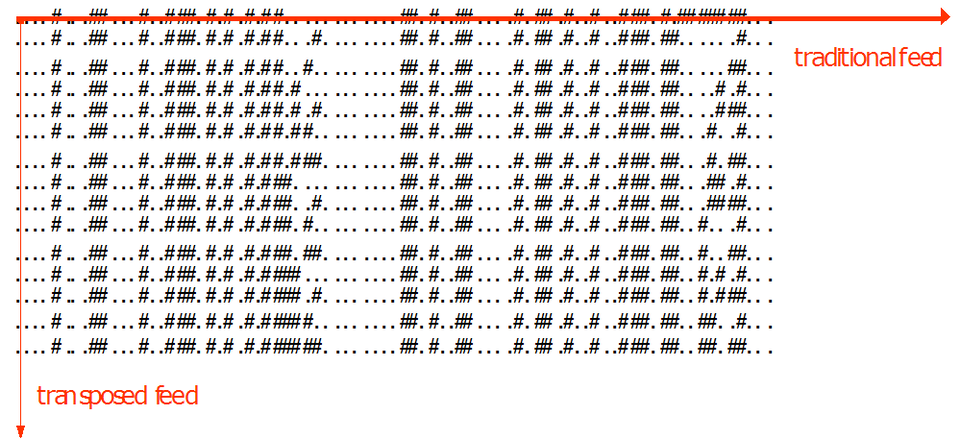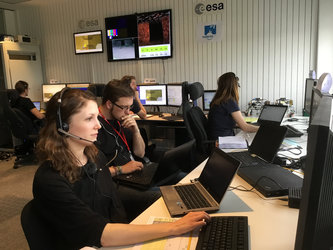Packet Compression
Simple Lossless Packet Compression
It is commonly believed that HKTM packets do not compress well. However, we have developed a lossless compression technique that provides massive data reduction. It is so simple that it can be implemented on-board. The packet compression technique groups packet of the same type and reads them using the binary transposed feed, which experiences far less transitions than the traditional feed. This allows use of very simple and efficient compression algorithms (e.g. Run Length Encoding).
Keywords: compression, observability
Results
The packet compression technique has been validated on ground with satisfactory results (e.g. only 14% of data needed for all HKTM Rosetta packets). It has been prototyped and validated on on-board hardware (LEON2 processor). The Packet Compression technology has been identified as enabling technology for the Mars atmospheric sample return mission.
Technology
The packet compression technique groups packet of the same type and reads them using the binary transposed feed, which experiences far less transitions than the traditional feed. This allows to use very simple and efficient compression algorithms (e.g. Run Length Encoding) to achieve good compression rates. The solution is so simple that can be easily implemented on-board.
The ESA Patent Group has decided to protect this Packet Compression technique by filing a patent application in the United States Patent and Trademark Office.
Development Team
Packet Compression has been developed by the ESA Studies and Special Projects Division.
Description
Housekeeping Telemetry is presently stored as CCSDS packets. Individual packets correlate to subsystems so they are a mix of different parameters and data types. The field length for each parameter is fixed but can be different depending on the type. The content of a packet is therefore heterogeneous in the sense that in contains different parameters of different data types. Different packets are usually written into the same packet store in time generated order. This causes more mixing of parameters and data types. As result of this mixing, it is difficult to compress using simple algorithms; so much so that RICE – the state of the art CCSDS recommendation – actually expanded some housekeeping telemetry packet stores in our tests.
We propose a simple data pre-processing in order to exploit the existing data redundancy more efficiently. First, we reduce the amount of mix by grouping together the packets of the same type and order them by generation time. Then we read these packets using the binary (at bit level) transposed feed instead of using the traditional feed. The transposed feed experiences far less transitions than the traditional feed. It exploits the structure of the housekeeping telemetry packets automatically. For example, if a parameter is allocated 16 bits of a packet and its value evolves slowly many of those 16 bits will remain identical in the transposed feed.

This pre-processing technique allows a simple compression algorithm like the Run Length Encoding (RLE) to achieve performances close to the best compression technique on the market (7zip). The combination of this pre-processing technique with Run Length Encoding has been validated with all Rosetta playback housekeeping TM data. The compressed version only needs 14% of the original data. It on-board feasibility has been demonstrated by implementing this technique on an on-board hardware processor (LEON2).
Without additional measures, the risk level increases along with increasing compression. However when combined with risk mitigation techniques we can actually increase robustness. For example, if we assume a Frame Error Rate (FER) of 10-4 and an average compression ratio of 14%, then dual diversity would reduce the probability of information loss down to 10-8 (10-4 x 10-4). In mission terms we can convert a poor link into a near perfect one while simultaneously getting the data 72% faster.
The benefits of this housekeeping packet compression technique are many in addition of the obvious reduction in bandwidth requirements:
- Get data faster: allows for faster reaction times.
- Increase link robustness. Spare link capacity can be used for dual diversity or other risk mitigation measures.
- Simplify engineering work: no need to optimise data structures since redundancies will be automatically removed.
Publications
- Martinez-Heras, J.A., Evans, D., Timm, R.; Housekeeping Telemetry Compression: When, how and why bother?. In the he International Conference on Advances in Satellite and Space Communications (SPACOMM 2009). Colmar, France July 20 - 25, 2009.
- Evans, D., Timm, R., Martinez-Heras, J.A., Perrotin, M; Housekeeping Data: Can You Afford Not to Compress It?. In the SpaceOps 2010 Conference. Huntsville, Alamaba, USA, April 25 – 30, 2010.







